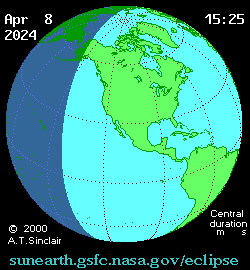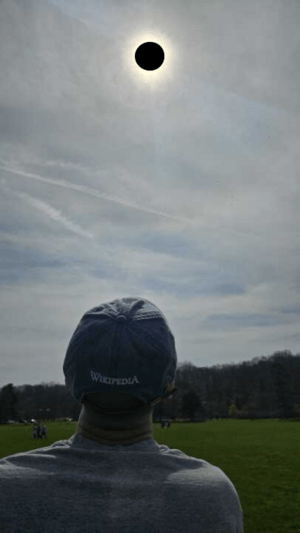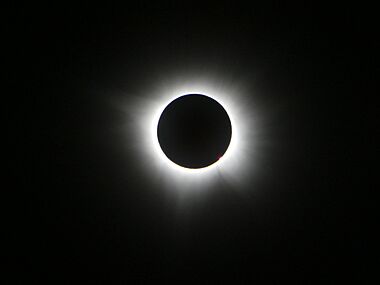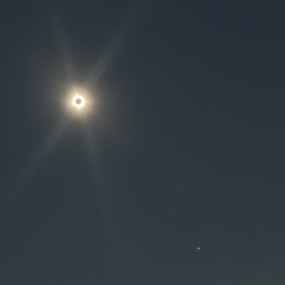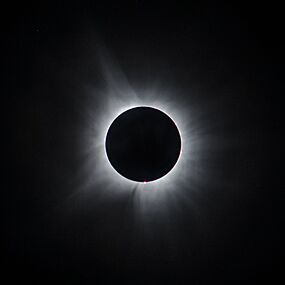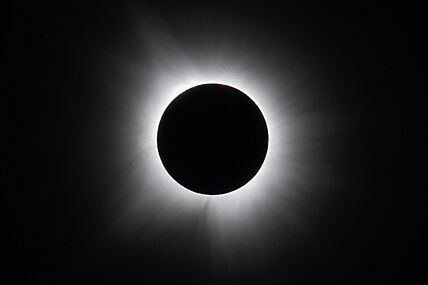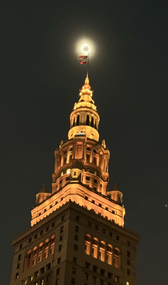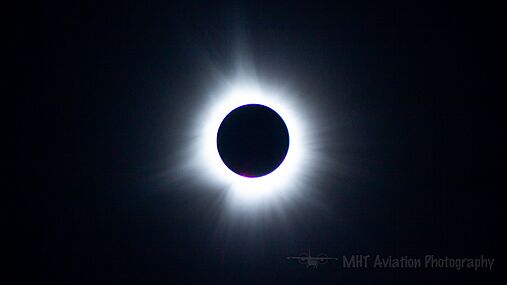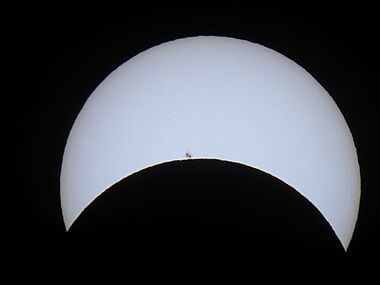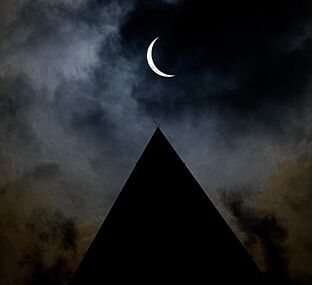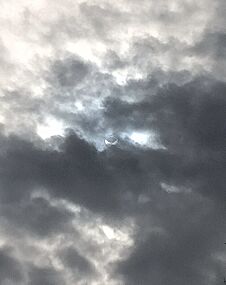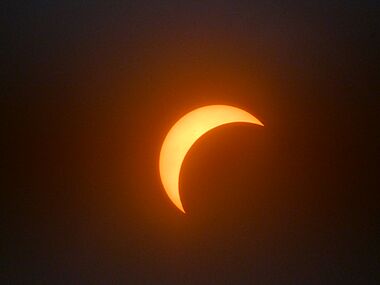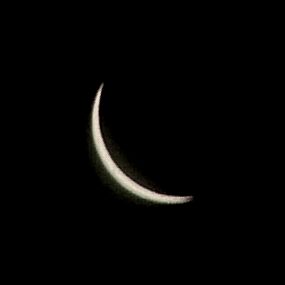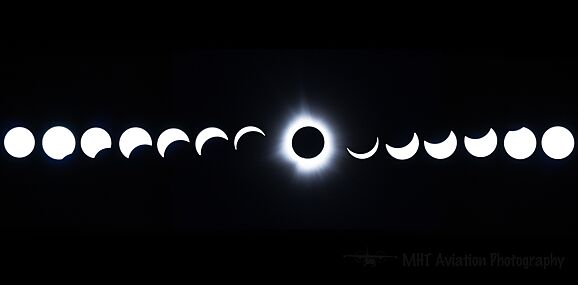Solar eclipse of April 8, 2024 facts for kids
The Solar Eclipse of April 8, 2024 was a total solar eclipse visible across a band covering parts of North America, from Mexico to Canada and crossing the contiguous United States. A solar eclipse occurs when the Moon passes between Earth and the Sun, thereby obscuring the Sun. A total solar eclipse occurs when the Moon's apparent diameter is larger than the Sun's, blocking all direct sunlight. Totality occurs only in a limited path across Earth's surface, with the partial solar eclipse visible over a larger surrounding region.
The Moon's apparent diameter was 5.5% larger than average. With a magnitude of 1.0566, the eclipse's longest duration of totality was 4 minutes and 28.13 seconds just 6 km (4 mi) north of the Mexican town of Nazas, Durango.
This eclipse was the first total solar eclipse visible from Canada since February 26, 1979; the first over Mexico since July 11, 1991; and the first over the United States since August 21, 2017. No other solar eclipse in the 21st century will be totally visible from all three countries. The next total solar eclipse in the US will be on March 30, 2033, which will pass over Alaska; the next total eclipse in the lower 48 states of the US will be on August 23, 2044; and the next total eclipse of similar width will take place on August 12, 2045 (traversing coast-to-coast similar to the 2017 eclipse).
The final solar eclipse of the year will occur on October 2, 2024.
Contents
Visibility in America
The totality of the solar eclipse was visible in a strip from the Pacific Ocean 230 miles (370 km) north of the Marquesas Islands and later in North America, beginning at the Pacific coast, then ascending in a northeasterly direction through Mexico, the United States, and Canada, before ending in the Atlantic Ocean.
Mexico
In Mexico, totality passed through the states of Sinaloa (including Mazatlán), Durango (including the city of Durango and Gómez Palacio), and Coahuila (including Torreón, Matamoros, Monclova, Sabinas, Ciudad Acuña, and Piedras Negras). A partial eclipse was visible across the remainder of the country, including 79% coverage of the solar disc in Mexico City.
United States
In the United States, totality was visible through the states of Texas (including parts of San Antonio, Austin, and Fort Worth and all of Arlington, Dallas, Killeen, Temple, Texarkana, Tyler, Sulphur Springs, and Waco), Oklahoma (including Idabel and Broken Bow), Arkansas (including Morrilton/Petit Jean, Hot Springs, Searcy, Jonesboro, and Little Rock), Missouri (including Cape Girardeau and Poplar Bluff), Tennessee (extreme northwestern corner of Lake County), Illinois (including Carbondale, where it intersects the path of the 2017 eclipse), Kentucky, Indiana (including Bloomington, Evansville, Indianapolis, Anderson, Muncie, Terre Haute, and Vincennes), Ohio (including Akron, Cleveland, Dayton, Lima, Lorain, Toledo, and Warren), Michigan (extreme southeastern corner of Monroe County), Pennsylvania (including Erie), Upstate New York (including Buffalo, Niagara Falls, Rochester, Syracuse, Watertown, the Adirondacks, Potsdam, and Plattsburgh), northern Vermont (including Burlington), New Hampshire, and Maine, with the line of totality going almost directly over the state's highest point Mount Katahdin. The largest city that was entirely in the path was Dallas, Texas. It was the second total eclipse visible from the central United States in just seven years, after the eclipse of August 21, 2017. It will be the last total solar eclipse visible in the contiguous United States until August 23, 2044.

A partial solar eclipse was visible in all of the other parts of the contiguous United States, Hawaii, and southeast Alaska (Alaska Panhandle).
Delta Air Lines scheduled two special eclipse-following flights: one from Austin to Detroit on a large-window A220-300, and one from Dallas to Detroit. Various other flights in the path of totality also avoided cloud cover entirely.
Canada
In Canada, totality was visible through parts of Southern Ontario (including Leamington, Fort Erie, Hamilton, Niagara Falls, Kingston, Prince Edward County, and Cornwall), parts of southern Quebec (including Montreal, Sherbrooke, Saint-Georges, and Lac-Mégantic), central New Brunswick (including Fredericton, Woodstock and Miramichi), western Prince Edward Island (including Tignish and Summerside), the northern tip of Cape Breton Island, Nova Scotia, and central Newfoundland (including Gander and Grand Falls-Windsor). Then, it ended on the eastern Atlantic coast of Newfoundland. Windsor, London, Toronto, and Ottawa lay just north of the path of totality, and Moncton just south of it.
A partial solar eclipse was visible in all of the other parts of Canada, except the western part of Yukon and the western tip of the Northwest Territories.
Central America and South America
The partial eclipse was seen in all Central American countries, from Belize to Panama, all the Greater Antilles (Cuba, Dominican Republic, Haiti, Puerto Rico, and Jamaica), and northern South America (Colombia).
Visibility in Other Continents
Europe
A partial eclipse passed over Svalbard (Norway), Iceland, Ireland, western parts of the United Kingdom, north-western parts of Spain and Portugal and the Azores, and the Canary Islands. Cloud cover prevented views of it from most of the British Isles, although it was seen in Western Scotland. Unusually, this eclipse extended below the horizon, where the greatest phase was observed at mid-nautical twilight in Galicia (Spain) and the beginning of astronomical twilight in Nouvelle-Aquitaine (France). The extension of the eclipse path within the twilight zone created what was likely the best observation window for the 12P/Pons–Brooks comet located closely to Jupiter.
Oceania
The partial eclipse was seen in Hawaii, eastern Kiribati (the eastern Phoenix Islands and the whole Line Islands), Tokelau, American Samoa except for its extreme western part, the Cook Islands, French Polynesia, and the Pitcairn Islands. Although all located east of the 180th meridian, the local time of the eclipse in Kiribati and Tokelau was Tuesday, April 9, 2024, because either UTC+13 or UTC+14 is observed in these areas.
Solar prominences
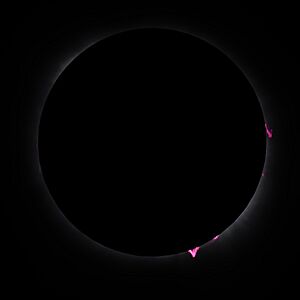
The eclipse occurred around the solar maximum, a period of greatest solar activity in the Sun's 11-year solar cycle, and it was predicted before the event that solar prominences could be visible during totality. Several observers reported seeing solar prominences during the event.
Impact
It was projected before the eclipse that there could be a $6 billion boost to the US economy due to the eclipse. The Mayor of Rochester, New York, Malik Evans, told reporters that the city was expected to bring in between $10–12 million to the city's economy from the Friday before the eclipse to the day of it.
One company that tracks Airbnb data likened the event to one of Taylor Swift's concerts taking place simultaneously, with visitors traveling from across the world to the path of totality in the US. In the United States, the prices of motels and hotels near the path of totality increased up to 100 percent on April 7 and April 8. Montreal saw a 20% surge in hotel occupancy for April 7th and 8th. It was the first total solar eclipse visible in Montreal since 1932. The next one will be in 2205.
A restaurant in Burlington, Vermont, said that after it was reported that up to 75,000 people would be visiting the city for the eclipse reservations filled up quickly causing them to have to bring on extra staff to meet demands. Other restaurants made concessions on business hours to meet the needs of the crowds. In Rochester, a task force was created to help mitigate the challenges that could come about with the estimated 300,000 to 500,000 visitors that were expected to visit during the eclipse. The state of Texas was projected to see up to a million visitors with cities along the path of totality cultivating festivals and other events.
The eclipse had been expected to affect solar power generation, as parts of the path of totality saw limited sunlight for over two hours. States such as Texas, California, and Florida were projected to be the most affected.
Areas in the area of totality saw significant increases in traffic, with departing tourists causing traffic jams. Many of those trying to pass through Franconia Notch in New Hampshire found themselves in jams lasting until 2 a.m. the following morning.
Responses
Arkansas Governor Sarah Huckabee Sanders preemptively declared a state of emergency related to the eclipse, citing the expected increase of travel to the state which may potentially result in transportation difficulties, such as in Fort Smith, where the police prepared for traffic congestion as hotels filled up with visitors from all over the United States and Canada. Bell County, Texas Judge David Blackburn preemptively declared a state of emergency in February 2024 due to the projected number of visitors to the area. The region surrounding Niagara Falls, Ontario, also declared a state of emergency; as an existing major tourist destination along the path of totality, it expected an influx of at least one million visitors on April 8.
The Las Vegas Sphere displayed eclipse-themed visuals in celebration of the eclipse.
Related eclipses
The eclipse is a member of a semester series. An eclipse in a semester series of solar eclipses repeats approximately every 177 days and 4 hours (a semester) at alternating nodes of the Moon's orbit. It is also part of saros series 139, repeating every 18 years, 11 days, 8 hours, containing 71 events, and part of a tritos cycle, repeating at alternating nodes every 135 synodic months (≈ 3986.63 days, or 11 years minus 1 month).
The path of the April 8, 2024, eclipse crossed the path of the prior total solar eclipse of August 21, 2017 with the intersection of the two paths being in southern Illinois, in Makanda, just south of Carbondale. The cities of Benton, Carbondale, Chester, Harrisburg, Marion, and Metropolis in Illinois; Cape Girardeau, Farmington, and Perryville in Missouri, as well as Paducah, Kentucky, were within a roughly 9,000-square-mile (23,000 km2) intersection of the paths of totality of both the 2017 and 2024 eclipses.
Gallery
Total
-
Totality as seen from Victoria de Durango, Durango
-
Totality with Venus as seen from Viola, Arkansas
-
Totality as seen from Russellville, Arkansas
-
Totality as seen from Hot Springs, Arkansas
-
Totality as seen from Plano, Texas, with solar prominences and chromosphere visible
-
Totality as seen from Dallas, Texas
-
Totality as seen from Austin, Texas
-
Totality as seen from Indianapolis, Indiana, with solar prominences visible
-
Totality as seen from Cleveland, Ohio, behind Terminal Tower
-
Totality as seen from James N. Allan Provincial Park in Ontario
-
April 8th Total Solar Eclipse Prominences from Rondeau Provincial Park in Ontario
-
Totality as seen from Fayston, Vermont
-
Totality as seen from Pittsburg, New Hampshire
Partial
-
Partial as seen from Santa Ana, California
-
Partial as seen from Indianapolis, Indiana
-
Partial as seen from Washington, D.C.
-
Partial as seen from Plainfield, New Jersey
-
Partial as seen from Philadelphia, Pennsylvania
-
Partial as seen from Marquette, Michigan
-
Partial as seen from Little Mountain, South Carolina
-
Partial as seen from San Nicolás de los Garza, Nuevo León
-
Partial as seen from New Orleans, Louisiana
Pinholes
-
Natural pinholes as seen from College Station, Texas
-
Natural pinholes as seen from Winder, Georgia
-
Pinhole made via cardboard box in Dallas, Texas
Miscellaneous
-
Phases of the April 2024 Total Solar Eclipse over Pittsburg, New Hampshire
See also
 In Spanish: Eclipse solar del 8 de abril de 2024 para niños
In Spanish: Eclipse solar del 8 de abril de 2024 para niños
- List of solar eclipses in the 21st century
- List of solar eclipses visible from the United States


